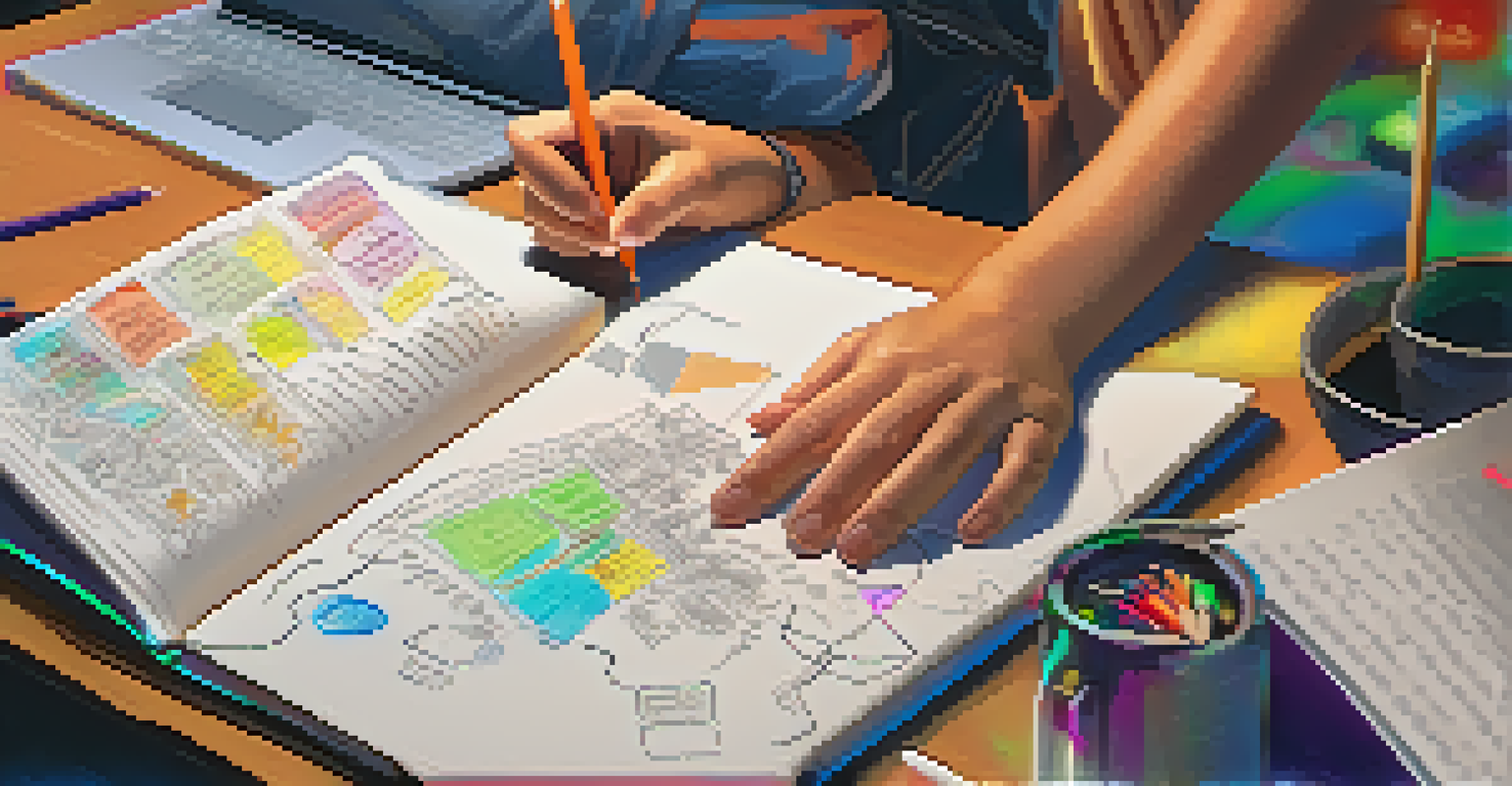Cross-Curricular Projects: Integrating STEAM Learning

Understanding STEAM: What It Means for Education
STEAM stands for Science, Technology, Engineering, Arts, and Mathematics. It's an educational approach that emphasizes the interconnectedness of these disciplines, encouraging students to engage in critical thinking and creativity. Unlike traditional methods that often isolate subjects, STEAM promotes a holistic learning experience that mirrors real-world scenarios.
Education is not the filling of a pail, but the lighting of a fire.
Imagine a classroom where students create a bridge design using math for calculations and art for aesthetics. This integration not only fosters a deeper understanding of each subject but also makes learning more engaging. By blending these areas, students can see the practical applications of their skills, making the learning process more relevant.
By incorporating the arts into STEM, educators can appeal to a broader range of learning styles. This approach helps students not only grasp complex concepts but also express their understanding in diverse ways, creating a richer educational environment.
Benefits of Cross-Curricular Projects in STEAM Learning
Cross-curricular projects offer numerous benefits, including improved student engagement and retention of information. When students can connect the dots between different subjects, they develop a more profound interest in learning. For instance, a project that combines biology and art can inspire students to explore both fields simultaneously.

Additionally, these projects encourage collaboration among students, fostering teamwork and communication skills. Working together on a common goal helps students appreciate diverse perspectives, which is crucial in today’s interconnected world. This collaborative aspect can lead to the development of soft skills that are valuable in both academic and professional settings.
STEAM Enhances Learning Engagement
Integrating Science, Technology, Engineering, Arts, and Mathematics fosters critical thinking and creativity through a holistic educational approach.
Finally, cross-curricular projects can help educators assess student understanding more effectively. By evaluating how well students can apply concepts from various subjects in a single project, teachers gain insight into their students’ learning processes and can tailor their instruction accordingly.
How to Design Effective Cross-Curricular Projects
Designing effective cross-curricular projects requires careful planning and collaboration among educators. Start by identifying learning objectives that align with the standards of each subject involved. For example, if you're combining science and art, you might focus on a project that explores environmental conservation through artistic expression.
The future belongs to those who believe in the beauty of their dreams.
Next, consider the resources and materials needed to facilitate the project. This might include technology for research, art supplies, or even field trips for hands-on experiences. Ensuring access to these resources can significantly impact the project's success, making it essential for educators to plan accordingly.
Lastly, encourage student input in the project design. When students feel ownership over their learning, they are more likely to be invested and motivated to succeed. This collaborative approach not only empowers students but also leads to more innovative and creative project outcomes.
Examples of Successful Cross-Curricular Projects
One inspiring example of a cross-curricular project is the 'City of the Future' initiative, where students combine architecture, urban planning, and environmental science. In this project, students design sustainable cities, incorporating principles of engineering while also considering artistic design elements. This hands-on experience allows them to apply their knowledge in a practical context.
Another great example is a project involving storytelling through technology. Students can write and illustrate their own stories while using coding to create interactive digital versions. This project merges language arts, technology, and design, illustrating how diverse subjects can come together to create a cohesive learning experience.
Collaboration Boosts Skill Development
Cross-curricular projects encourage teamwork and communication, helping students appreciate diverse perspectives and enhancing their soft skills.
These examples show how cross-curricular projects can ignite creativity and critical thinking. By engaging students in real-world challenges, these projects help them develop essential skills while deepening their understanding of various subjects.
Challenges in Implementing Cross-Curricular Projects
While cross-curricular projects offer numerous benefits, they also come with challenges. One significant hurdle is the need for collaboration among teachers from different disciplines. Coordinating schedules and aligning curricula can be daunting, requiring time and effort to ensure everyone is on the same page.
Another challenge is assessing student performance across multiple subjects. Traditional grading systems may not adequately reflect a student's understanding or skills gained from a cross-curricular project. Educators must develop clear, flexible assessment criteria that encompass various disciplines while providing meaningful feedback.
Lastly, there may be resistance from both educators and students who are accustomed to traditional teaching methods. Overcoming this mindset requires ongoing professional development and support, encouraging educators to embrace innovative teaching strategies that benefit all learners.
The Role of Technology in Cross-Curricular Learning
Technology plays a vital role in enhancing cross-curricular projects. With tools like interactive whiteboards, online collaboration platforms, and educational apps, students can explore subjects in new and exciting ways. For example, they can use simulation software to model scientific experiments while documenting their findings through digital storytelling.
Additionally, technology enables students to access vast resources for research, helping them to broaden their understanding of various topics. Online databases, virtual field trips, and multimedia presentations can all be incorporated into cross-curricular projects, making learning more dynamic and engaging.
Technology Enriches Learning Experiences
Utilizing technology in cross-curricular projects allows students to engage with subjects dynamically, preparing them for a tech-driven world.
Moreover, technology fosters communication and collaboration among students, whether they're working in the same classroom or connecting with peers across the globe. This interconnectedness not only enriches their learning experience but also prepares them for a tech-driven world.
Encouraging Lifelong Learning Through Cross-Curricular Projects
Cross-curricular projects not only engage students but also instill a love for learning that lasts a lifetime. By allowing students to explore topics from multiple angles, they develop a sense of curiosity and a desire for knowledge that extends beyond the classroom. This approach nurtures critical thinking and creativity, essential skills for any lifelong learner.
Furthermore, as students collaborate on projects, they learn the importance of persistence and adaptability. Facing challenges together teaches them resilience, showing that setbacks are part of the learning process. These lessons help students cultivate a growth mindset, where they view challenges as opportunities to improve.

Ultimately, cross-curricular projects prepare students for the complexities of the modern world. By equipping them with diverse skills and fostering a passion for learning, educators can inspire the next generation of innovators and problem solvers.